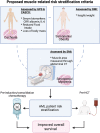Cachectic muscle wasting in acute myeloid leukaemia: a sleeping giant with dire clinical consequences
- PMID: 34879436
- PMCID: PMC8818658
- DOI: 10.1002/jcsm.12880
Cachectic muscle wasting in acute myeloid leukaemia: a sleeping giant with dire clinical consequences
Abstract
Acute myeloid leukaemia (AML) is a haematological malignancy with poor survival odds, particularly in the older (>65 years) population, in whom it is most prevalent. Treatment consists of induction and consolidation chemotherapy to remit the cancer followed by potentially curative haematopoietic cell transplantation. These intense treatments are debilitating and increase the risk of mortality. Patient stratification is used to mitigate this risk and considers a variety of factors, including body mass, to determine whether a patient is suitable for any or all treatment options. Skeletal muscle mass, the primary constituent of the body lean mass, may be a better predictor of patient suitability for, and outcomes of, AML treatment. Yet skeletal muscle is compromised by a variety of factors associated with AML and its clinical treatment consistent with cachexia, a life-threatening body wasting syndrome. Cachectic muscle wasting is associated with both cancer and anticancer chemotherapy. Although not traditionally associated with haematological cancers, cachexia is observed in AML and can have dire consequences. In this review, we discuss the importance of addressing skeletal muscle mass and cachexia within the AML clinical landscape in view of improving survivability of this disease.
Keywords: Acute myeloid leukaemia; Cachexia; Cancer; Chemotherapy; Myopathy; Risk stratification; Skeletal muscle.
© 2021 The Authors. Journal of Cachexia, Sarcopenia and Muscle published by John Wiley & Sons Ltd on behalf of Society on Sarcopenia, Cachexia and Wasting Disorders.
Conflict of interest statement
None declared.
Figures


References
-
- Hilmi M, Jouinot A, Burns R, Pigneur F, Mounier R, Gondin J, et al. Body composition and sarcopenia: the next‐generation of personalized oncology and pharmacology? Pharmacol Ther 2019;196:135–159. - PubMed
-
- Argilés JM, Busquets S, Stemmler B, López‐Soriano FJ. Cancer cachexia: understanding the molecular basis. Nat Rev Cancer 2014;14:754–762. - PubMed
Publication types
MeSH terms
LinkOut - more resources
Full Text Sources
Other Literature Sources
Medical

